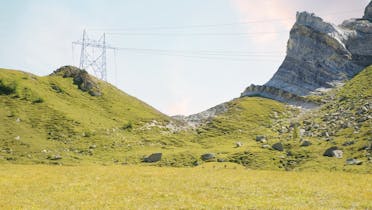Grid project Grid

Yesterday evening, Swissgrid and its partners celebrated the end of the rough construction of the new substation in Biasca (TI). To replace the current air-insulated system built in 1956, a gas-insulated system will be installed in the newly completed building, which is located a few steps from the south portal of the Gotthard Base Tunnel. Work started in September 2023 and is scheduled for completion in 2025.
However, in addition to the necessary technical installations, the new building encompasses much more: renewable energy, biodiversity, land and public transport. We will find out together in this blog what links these aspects to the new substation.
An essential element for transporting renewable energy
With the help of its partners, Swissgrid transports electricity from the production centres to the consumer. And the Canton of Ticino is a key part of our transmission grid. There are two main reasons for this:
- Firstly, Ticino generates large volumes of hydroelectric electricity. Just a stone’s throw from the substation, for example, the Ofible power station in Biasca has an installed capacity of 418 MW. Combined with the hydroelectric power stations in the north of Ticino, this constitutes a valuable reserve of renewable energy.
- Moreover, Ticino is in a strategic location: it is situated between the northern Alps and Italy. As you know, Switzerland is not an island, but is closely connected to the European electricity grid at 41 points. This interconnection is important to ensure the stability of the grid and the availability of energy.
This is where the Biasca substation comes in: it represents an important hub for transporting renewable energy throughout Ticino and the rest of Switzerland. The construction costs for the new substation amount to around CHF 35 million. Overall, over the next 30 years, Swissgrid will invest around CHF 1 billion in the development and modernisation of the grids in Ticino.
Returning valuable areas to man and nature
Besides being essential for transporting electricity, the Biasca substation is an important part of the electricity grid of the future. It will allow us to optimise the power lines in northern Ticino. Thanks to the extensive joint planning work carried out by Swissgrid, SBB, Azienda Elettrica Ticinese AET and the Canton of Ticino as part of the Studio Generale initiative, it will be possible to remove around 70 km of overhead lines once the projects envisaged in the first stage of the study have been completed, restoring valuable areas to man and nature in the process. For more details, please see our previous blogs «Power lines and regional planning go hand in hand in Ticino» and «Studio Generale: Exploiting synergies together».
A contribution towards greener transport
A gas-insulated system will replace the current air-insulated system in the new substation building in Biasca. The new system will be much more compact and take up less room, enabling two frequency inverters to be installed for the SBB grid in the space made available as a result.
The Swissgrid and SBB grids will be connected in the future thanks to the valuable cooperation between the two grid operators. If necessary, SBB will be able to tap into our grid to provide the electricity required to transport people and goods by rail.
Sustainability is a key concept for Swissgrid. Contributing to the competitiveness of public transport, which is more environmentally friendly than motorised traffic, means taking a small but significant step towards a more sustainable world. This is a source of great pride for us.
In favour of biodiversity
There is one last aspect that needs to be emphasised. The Biasca substation is surrounded by green areas that may seem quite ordinary at first glance. Yet this grassland is more valuable than it initially appears. It actually consists of lean meadows and extensive hay meadows.
Due to the intensive exploitation of land, this type of grassland has become increasingly rare in Switzerland in recent years and is protected by federal legislation.
Once the work on the substation has been completed, the southern part of the area will be left entirely as grassland. In addition, the railway embankment to the east of the plant will be converted into grassland by recovering excavated material.
Thanks to these interventions, plant species that today struggle to find suitable places to develop in Switzerland will be able to enjoy more space in the area surrounding the new substation. Consequently, Swissgrid is making an important contribution to biodiversity.
For the well-being of our country
The new Biasca substation building will therefore safeguard much more than you might think. However, we must not forget that its construction is the result of the hard work of all the partners involved in the project. The video below is a testimony to this important work.
We would like to take this opportunity to once again express our heartfelt thanks to all the workers, planners and employees on the construction site for the commitment, professionalism and dedication they have shown at every stage of the project. This work has been instrumental in enabling us to reach this important milestone and will make a valuable contribution to the well-being of our country.








